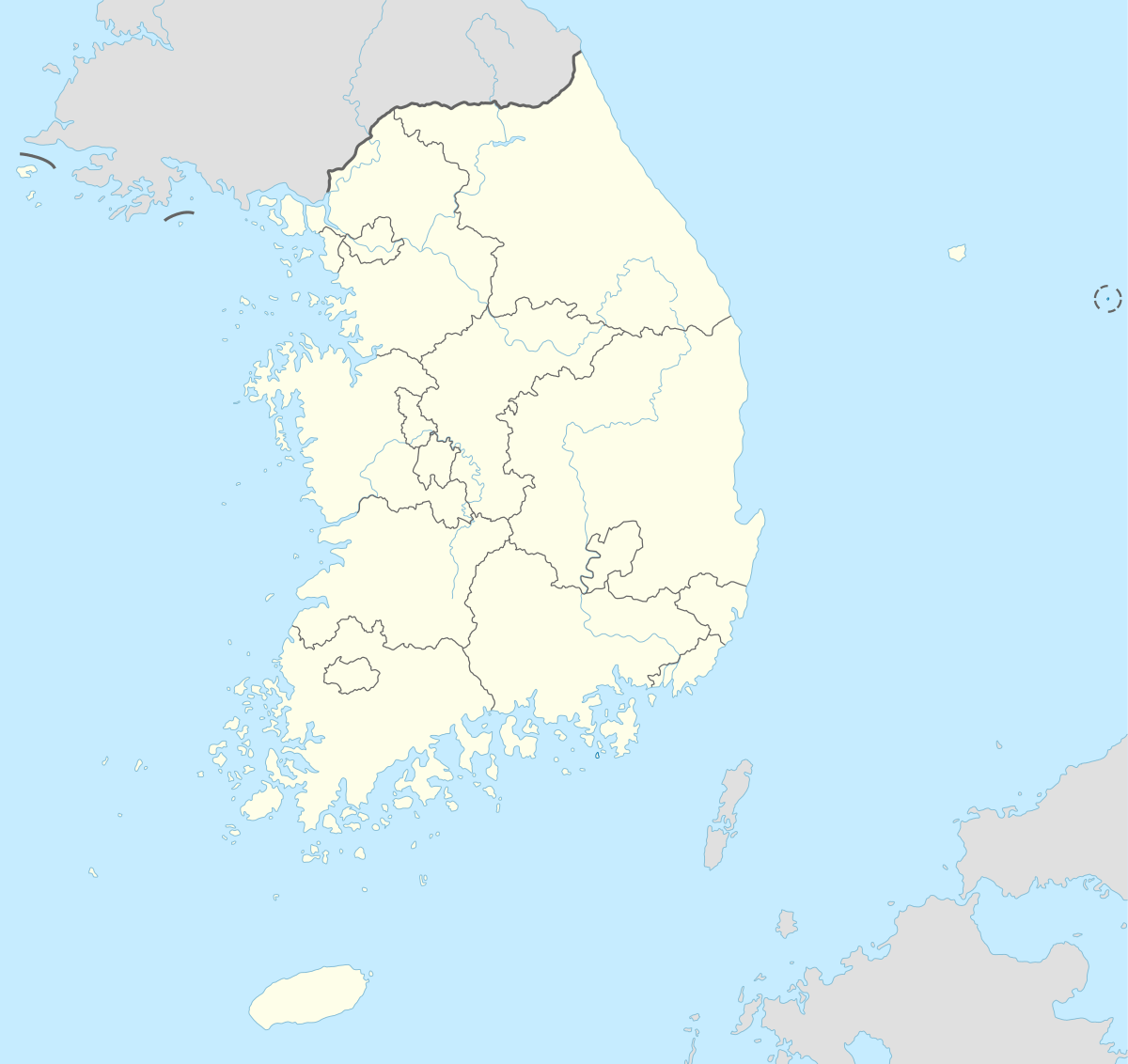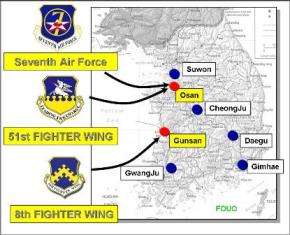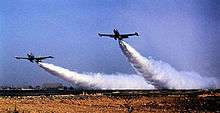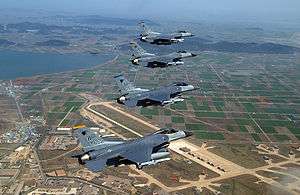Kunsan Air Base
Kunsan K-8 Air Base | |
|---|---|
| Part of Pacific Air Forces (PACAF) | |
| Located near: Gunsan, South Korea | |
|
F-16C Fighting Falcons over Kunsan AB | |
 Kunsan AB Location of Kunsan Air Base, South Korea | |
| Coordinates | 35°54′13″N 126°36′57″E / 35.90361°N 126.61583°E |
| Site information | |
| Controlled by |
|
| Site history | |
| Built | 1938 |
| In use | 1938-Present |
| Garrison information | |
| Garrison |
 8th Fighter Wing (USAF) |
| Airfield information | |||||||||||
|---|---|---|---|---|---|---|---|---|---|---|---|
| IATA: none – ICAO: RKJK | |||||||||||
| Summary | |||||||||||
| Elevation AMSL | 29 ft / 9 m | ||||||||||
| Website | www.kunsan.af.mil | ||||||||||
| Runways | |||||||||||
| |||||||||||
Kunsan K-8 Air Base is a United States Air Force base located at Gunsan Airport, which is on the west coast of the South Korean peninsula bordered by the Yellow Sea. It is at the town of Gunsan about 150 miles (240 km) south of Seoul. The town (군산시 in Korean) can be romanized as both Gunsan and Kunsan. The United States Air Force uses Gunsan to refer to the town, and Kunsan to refer to the base.
Kunsan Air Base is the home of the 8th Fighter Wing, "The Wolf Pack," assigned to the Pacific Air Forces Seventh Air Force and the 38th Fighter Group of the Republic of Korea Air Force. It is one of two major Air Force installations operated by the United States Forces Korea, the other being Osan Air Base.
Units
The following major units are stationed at Kunsan Air Base:
- 8th Fighter Wing
- 8th Operations Group (Tail Code: WP)
- 35th Fighter Squadron (35 FS) (F-16C/D, Blue tail stripe)
- 80th Fighter Squadron (80 FS) (F-16C/D, Gold tail stripe)
- 8th Maintenance Group
- 8th Mission Support Group
- 8th Medical Group
- 8th Operations Group (Tail Code: WP)
- 2-1 ADA (US Army, 35th ADA Brigade, 8th Army)
- Area Defense Counsel
- American Forces Network
- Army and Air Force Exchange Service
- Defense Commissary Agency
- Office of Special Investigations
- Republic of Korea Air Force
- 38th Fighter Group
- 111th Fighter Squadron (111대대) (KF-16C/D - F-16 block 50/52)
- 38th Fighter Group
History




The history of Kunsan Air Base dates back to 1938, when Japanese forces occupying Korea built a base near Kunsan for fighter-interceptor aircraft.
The United States first used the base in 1945, but on a very small scale. From 1945 to 1950, the Army and later the Air Force intermittently operated small detachments from Kunsan, with these detachments maintaining liaison aircraft. At most these detachments contained a handful of people. When the United States pulled its combat units out of the Republic of Korea in 1949, it left only a Military Assistance Advisory Group in the country, and the periodic detachments at Kunsan became even more infrequent.
Korean War
When the Korean War broke out on 25 June 1950, Kunsan Air Base had no United States flying units assigned. In their rapid advance, the invading North Koreans captured Kunsan Air Base on 13 July 1950.
The 24th Infantry Division retook Kunsan in October 1950, and the Chinese Communist Forces (CCF) Intervention Campaign that winter failed to push far enough south to put Kunsan in jeopardy. United States forces first operated in significant numbers from the base in 1951.
The first Air Force unit to be assigned to the base was the 27th Fighter-Escort Wing, which arrived on 1 April 1951. The 27th Fighter Escort Wing was one of the first F-84 units to see combat action in Korea and earned numerous honors and awards for their combat record during the Korean War.
Improvements to the base were needed, however, to accommodate jet fighters. The 27th FEW was reassigned at the end April and The Army's 808th Engineer Aviation Battalion built a 5,000 feet (1,500 m) runway to replace the sod runway constructed by Japanese. This runway is now known as Taxiway Charlie (06/24). By August, construction had progressed to the point that heavier units could be based at Kusan and the Air Force assigned the 3rd Bombardment Wing to Kunsan.
The 3rd Bomb Wing consisting of the 8th, 13th and 90th Bomb Squadrons flew the Douglas B-26 Invader bomber during the war, remaining at Kunsan from August 1951 until October 1954. A Marine aviation squadron, VMF(N)-513, arrived in April 1952, and a few months later the base added the 474th Fighter-Bomber Group, which included three squadrons of F-84 fighters, bringing the total size of the operation to one wing, one group, and a Marine fighter squadron. The 474th bombed and strafed such targets as bunkers, troops, artillery positions, bridges, vehicles, airfields, and power plants, and sometimes escorted bombers that attacked munitions factories and other objectives.
In April 1953, the 474th Fighter-Bomber Group returned to the United States and was replaced by the 49th Fighter-Bomber Wing, also flying the F-84.
During the Korean War, the large number of locations used for bases and the similarity of some geographical names prompted the Air Force to use alphanumeric identifiers for bases in addition to their proper designations. Under this system, each base in Korea received a "K number," simplifying positive identification when referring to the various bases. Kunsan received the number K-8, while Osan Air Base was also known as K-55.
Cold War
After hostilities ceased, the base began to draw down. The F-84 forces of the 49th Fighter-Bomber Wing left in November 1953, and by October 1954 the host unit of the base, the 3d Bombardment Wing, also departed. This left the base with a much-reduced mission. From 1953 to 1954, the 808th and 841st Engineering Aviation Battalions constructed what is today’s main runway. For the next several years Kunsan merely hosted periodic rotations of fighter and light bomber squadrons, with base facilities maintained and operated by an air base group. In 1957 and 1958, the 6170th Air Base Group began to upgrade base facilities, increasing the runway from 5,000 to 9,000 feet (1,500 to 2,700 m) and building new dormitories.
Until the late 1960s, though, Kunsan remained relatively dormant, hosting temporary deployments of flying units and serving as a safe haven base for aircraft evacuated from Okinawa and Guam during typhoons. In 1965, the Republic of Korea Air Force assigned a squadron of F-86 fighters to the base. This ROKAF unit was the only permanently assigned flying contingent at Kunsan until after the Pueblo incident in 1968.

At an unknown date in this time frame, the US Army 38th Air Defense Artillery Brigade assigned Battery B, 6th Battalion 44th Air Defense Artillery Group, a HAWK missile unit to Kunsan AB. The Tactical Operations site was located on a hill just off the coast, but near the base. Its mission was to defend the base from air attack. The Hawk site and all hardware was turned over to the Korean Army sometime in the early 1990s. After the Pueblo was captured by the North Koreans in 1968;the 4th Tactical Fighter Wing deployed to Korea on January 25, 1968; Under the command of Col. Jack Hayes; F-4Ds arrived at Kunsan on January 29, 1968. In March Col. Hayes was replaced by Col. Chuck Yeager, the 4th remained in Korea until replaced by 354th. The 354th Tactical Fighter Wing, consisting of the Kansas Air National Guard (ANG) and a few members of the DC-ANG flying the F-100 Super Sabre, arrived at Kunsan in July 1968, as part of the buildup of forces in Korea in the wake of the 1968 seizure of the USS Pueblo by the North Koreans. In 1969 the wing began a transition from the F-100 to the F-4 Phantom. The 354th remained until June 1970, when the base again returned to hosting temporary deployments, such as the four-month activation of the 54th Tactical Fighter Wing from June through October 1970.
The 3d Tactical Fighter Wing, previously designated the 3d Bombardment Wing, stationed at Kunsan in the early 1950s, arrived in March 1971 to assume control of the base. Like the 354th and 54th, the 3d Tactical Fighter Wing flew the F-4 Phantom. When it first arrived in May, the wing contained the 35th and 36th Tactical Fighter Squadrons. In September, the 80th Tactical Fighter Squadron replaced the 36th.
In September 1974 the 8th Tactical Fighter Wing, the "Wolf Pack," was transferred from Ubon Air Base, Thailand to replace the 3rd at Kunsan. The move took place in name only, as the 8th moved without personnel or equipment, absorbing all assets of the 3d Tactical Fighter Wing. This included the two flying squadrons, which continued to operate as the 35th and 80th Tactical Fighter Squadrons, reuniting the wing with two of its original squadrons.
Since then, the 8th has continued to serve as host unit of Kunsan Air Base, continually improving the base’s facilities over the years.
Major Commands
- US Army Pacific Air Command, (1946–47)
- Far East Air Forces, (1947–57)
- Pacific Air Forces, (1957–present)
Base operating units
- 27th Fighter-Escort Wing, (April – May 1951)
- 931st Engineering Aviation Group (May – August 1951)
- 3d Bombardment Wing (August 1951 – September 1954)
- 6170th Air Base Group (September 1954 – April 1956)
- 6170th Air Base Squadron (April 1956 – March 1959)
- 6175th Air Base Group (March 1959 – August 1968)
- 354th Tactical Fighter Wing (August 1968 – June 1970)
- 6175th Air Base Group (June 1970 – March 1971)
- 3d Tactical Fighter Wing (March 1971 – September 1974)
- 8th Fighter Wing (September 1974 – present)
Major USAF units assigned
- 27th Fighter-Escort Wing (April 1951)
- 3d Bombardment Wing (August 1951 - October 1954)
- 474th Fighter-Bomber Wing (July 1952 - April 1953)
- 49th Fighter-Bomber Wing (April - November 1953)
- 354th Tactical Fighter Wing (July 1968 - June 1970)
- 54th Tactical Fighter Wing (June - October 1970)
- 3d Tactical Fighter Wing (March 1971 - September 1974)
- 8th Fighter Wing (September 1974–present)
Kunsan has provided support for F-84G Thunderjet, B-26 Invader, F-86 Sabre, RF-100 Super Sabre, RB-57 Canberra, F-100 Super Sabre, F-4 Phantom II, and F-16 Fighting Falcon operations.
See also
References
- ↑ Airport information for RKJK from DAFIF (effective October 2006)
- ↑ Airport information for KUV at Great Circle Mapper. Source: DAFIF (effective October 2006).
-
 This article incorporates public domain material from the Air Force Historical Research Agency website http://www.afhra.af.mil/.
This article incorporates public domain material from the Air Force Historical Research Agency website http://www.afhra.af.mil/.
- USAAS-USAAC-USAAF-USAF Aircraft Serial Numbers--1908 to present
- Some of the text in this article was taken from pages on the Kunsan Air Base website, which as a work of the U.S. Government is presumed to be a public domain resource. That information was supplemented by:
- Endicott, Judy G. (1999) Active Air Force wings as of 1 October 1995; USAF active flying, space, and missile squadrons as of 1 October 1995. Maxwell AFB, Alabama: Office of Air Force History. CD-ROM.
- Fletcher, Harry R. (1989) Air Force Bases Volume II, Active Air Force Bases outside the United States of America on 17 September 1982. Maxwell AFB, Alabama: Office of Air Force History. ISBN 0-912799-53-6
- Maurer, Maurer (1983). Air Force Combat Units Of World War II. Maxwell AFB, Alabama: Office of Air Force History. ISBN 0-89201-092-4.
- Ravenstein, Charles A. (1984). Air Force Combat Wings Lineage and Honors Histories 1947-1977. Maxwell AFB, Alabama: Office of Air Force History. ISBN 0-912799-12-9.
- Rogers, Brian (2005). United States Air Force Unit Designations Since 1978. Hinkley, England: Midland Publications. ISBN 1-85780-197-0.
- Thompson, Warren (2000). B-26 Invader Units over Korea. Osprey Publishing ISBN 1-84176-080-3
- Thompson, Warren (2001). F-80 Shooting Star Units over Korea. Osprey Publishing ISBN 1-84176-225-3
External links
| Wikimedia Commons has media related to Kunsan Air Base. |
- Kunsan Air Base, official U.S. Air Force website
- History of Kunsan Air Base
- Current weather for RKJK at NOAA/NWS
- Accident history for KUV at Aviation Safety Network


